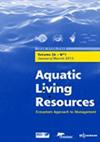Comparisons of day-time and night-time hydroacoustic surveys in temperate lakes
IF 1.5
4区 农林科学
Q3 FISHERIES
引用次数: 0
Abstract
In recent years, due to an increased need for non-intrusive sampling techniques, hydroacoustics has attracted attention in fishery science and management. Efforts to promote standardisation are increasing the accuracy, efficiency, and comparability of this method. The European Water Framework Directive and the Standard Operating Procedures for Fisheries Hydroacoustic Surveys in North American Great Lakes has recommended that surveys be conducted at night. At night, fish usually disperse in the water column, thus allowing for single echo detection and subsequent accurate fish size estimation, while day-time schooling behaviour hampers the estimation of fish size. However, sampling during the day would often be safer and cheaper. This study analyses how fisheries hydroacoustic results differ between day-time and night-time surveys, using data from 14 natural temperate lakes of various size. Data collected during the day and night at two depth layers linked to thermal stratification were compared in terms of acoustic scattering strength, target strength, and biomass estimates. The results showed a significant correlation between day-time and night-time estimates, though biomass in the upper layer was biased for day-time surveys, mainly due to incorrect fish size estimates resulting from rare single echo detections and schooling behaviour. Biomass estimates for the lower depth layer did not significantly differ between the two diel periods. Thus, this study confirms that hydroacoustic sampling in temperate lakes should be performed at night for accurate fish stock biomass estimates.
温带湖泊昼夜水声调查的比较
近年来,由于对非侵入式采样技术的需求增加,水声学在渔业科学和管理中引起了人们的关注。促进标准化的努力正在提高该方法的准确性、效率和可比性。《欧洲水框架指令》和《北美五大湖渔业水声调查标准作业程序》建议在夜间进行调查。在夜间,鱼通常分散在水柱中,因此可以进行单回声探测并随后准确估计鱼的大小,而白天的鱼群行为阻碍了对鱼大小的估计。然而,在白天取样通常更安全、更便宜。这项研究分析了渔业水声结果在白天和夜间调查中的差异,使用了14个不同大小的自然温带湖泊的数据。在与热分层相关的两个深层白天和夜间收集的数据在声散射强度、目标强度和生物量估算方面进行了比较。结果显示,白天和夜间的估计之间存在显著的相关性,尽管上层的生物量在白天的调查中存在偏差,这主要是由于罕见的单回声探测和鱼群行为导致的鱼类大小估计不正确。较低深度层的生物量估计值在两个周期之间没有显著差异。因此,本研究证实,温带湖泊的水声采样应在夜间进行,以准确估计鱼类种群生物量。
本文章由计算机程序翻译,如有差异,请以英文原文为准。
求助全文
约1分钟内获得全文
求助全文
来源期刊

Aquatic Living Resources
农林科学-海洋与淡水生物学
CiteScore
2.30
自引率
0.00%
发文量
10
审稿时长
>24 weeks
期刊介绍:
Aquatic Living Resources publishes original research papers, review articles and propective notes dealing with all exploited (i.e. fished or farmed) living resources in marine, brackish and freshwater environments.
Priority is given to ecosystem-based approaches to the study of fishery and aquaculture social-ecological systems, including biological, ecological, economic and social dimensions.
Research on the development of interdisciplinary methods and tools which can usefully support the design, implementation and evaluation of alternative management strategies for fisheries and/or aquaculture systems at different scales is particularly welcome by the journal. This includes the exploration of scenarios and strategies for the conservation of aquatic biodiversity and research relating to the development of integrated assessment approaches aimed at ensuring sustainable and high quality uses of aquatic living resources.
 求助内容:
求助内容: 应助结果提醒方式:
应助结果提醒方式:


